Article by Nora Kovacs // Apr. 17, 2019
I crane my neck to see past someone’s head. The woman next to me stretches onto her tippy toes to catch a glimpse. A suited man with perfectly coiffed hair and a briefcase in hand lets out an exasperated sigh each time his view is obstructed. One performer cracks open a can of beer and takes a sip before pouring it on the glass wall that separates us from him; another sets fire to a bouquet of dried roses, filling the room with a smoky floral stench. “We live in dark times,” model/muse Eliza Douglas croons in a melancholy voice.
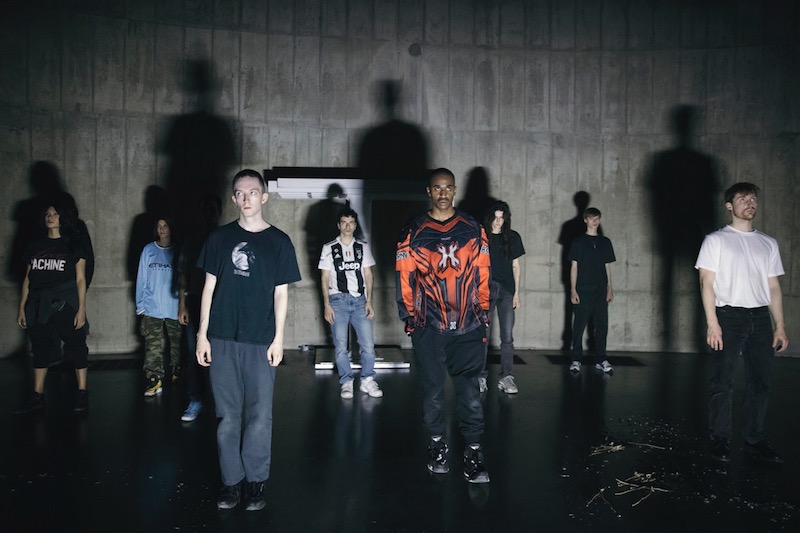
Nomi Ruiz, Frances Chiaverini, Mickey Mahar, Enad Marouf, Josh Johnson, Eliza Douglas, Maoro Bultheel, Billy Bultheel in Anne Imhof, ‘Sex’, 2019, Tate Modern, London // Photography: Nadine Fraczkowski, Courtesy the artist and Galerie Buchholz, Berlin/Cologne/New York
The anticipation surrounding the latest BMW Tate Live Exhibition at Tate Modern had been palpable in the months leading up to it, this March. The exhibition, titled ‘Sex’, carried a mysterious air about it, with hardly any information for viewers to go off of, except that German artist Anne Imhof would take over the brooding brutalist spaces of the Tanks at Tate Modern for ten days and five nights. There would be live works, music, paintings, sculptures and installations—about as broad of a description as you can get—and viewers were warned that the performances would contain strobe lighting.
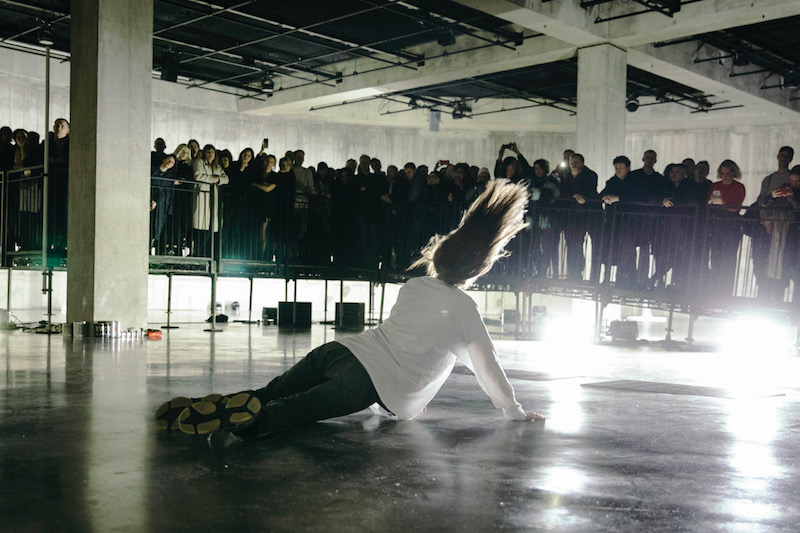
Eliza Douglas in Anne Imhof, ‘Sex’, 2019, Tate Modern, London // Photography: Nadine Fraczkowski, Courtesy the artist and Galerie Buchholz, Berlin/Cologne/New York.
The combination of these elements can be loosely described as a durational spectacle and has become somewhat of a trademark for Imhof after the success of ‘Angst’ and ‘Faust’, with the latter winning Imhof the Golden Lion at the 2017 Venice Biennale. As with the Venice Biennale performance, there was a lot of waiting involved in ‘Sex’; waiting for tickets to be released, waiting for the exhibition to open, waiting to enter the Tanks, waiting for the performance to “begin” and waiting for something to “happen” over the course of the four-hour piece. Like in ‘Faust’, this waiting soon transformed into a feeling of impending doom, as Imhof’s performers stood dead-eyed, gazing at the audience as we entered the Tanks.
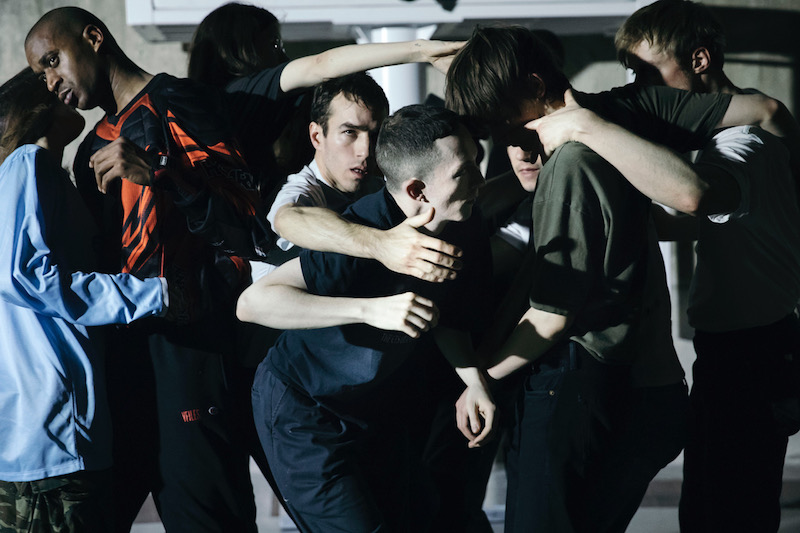
Frances Chiaverini, Josh Johnson, Eliza Douglas, Ian Edmonds, Mickey Mahar, Enad Marouf, Jakob Eilinghoff, Billy Bultheel in Anne Imhof, ‘Sex’, 2019, Tate Modern, London // Photography: Nadine Fraczkowski, Courtesy the artist and Galerie Buchholz, Berlin/Cologne/New York
Take one look at the performers, as well as the crowd, and Imhof’s work exudes trendiness. From Balenciaga sneakers and an overall ‘normcore’ aesthetic to sweatshirts clad with the smiling face of millennial sensation Alexandria Ocasio-Cortez, ‘Sex’ is undoubtedly fashionable, tastefully tinged with irony. With collaborations between contemporary art and fashion growing increasingly prevalent, this type of trendiness can often put people off, as they hesitate to hop on the cooler-than-cool bandwagon of Imhof’s cult of personality. Unlike some of her peers, however, Imhof compels us to question those very trends, de-contextualizing symbols of contemporary culture and lacing them with something more ominous.
We thereby oscillate between familiarity and ambivalence. Whether we showed up to see ‘Sex’ because we saw Imhof’s previous works all over Instagram or because we are intrigued by the prospect of taking part in four hours of post-apocalyptic poetry, we have all walked into the performance to see and be seen. Whether we stare back at the performers, mirroring their unwavering sullenness, or shyly avert our gaze when their eyes meet ours, we recognize ourselves in Imhof’s performers and that makes us self-conscious, uncomfortable and at times defensive.
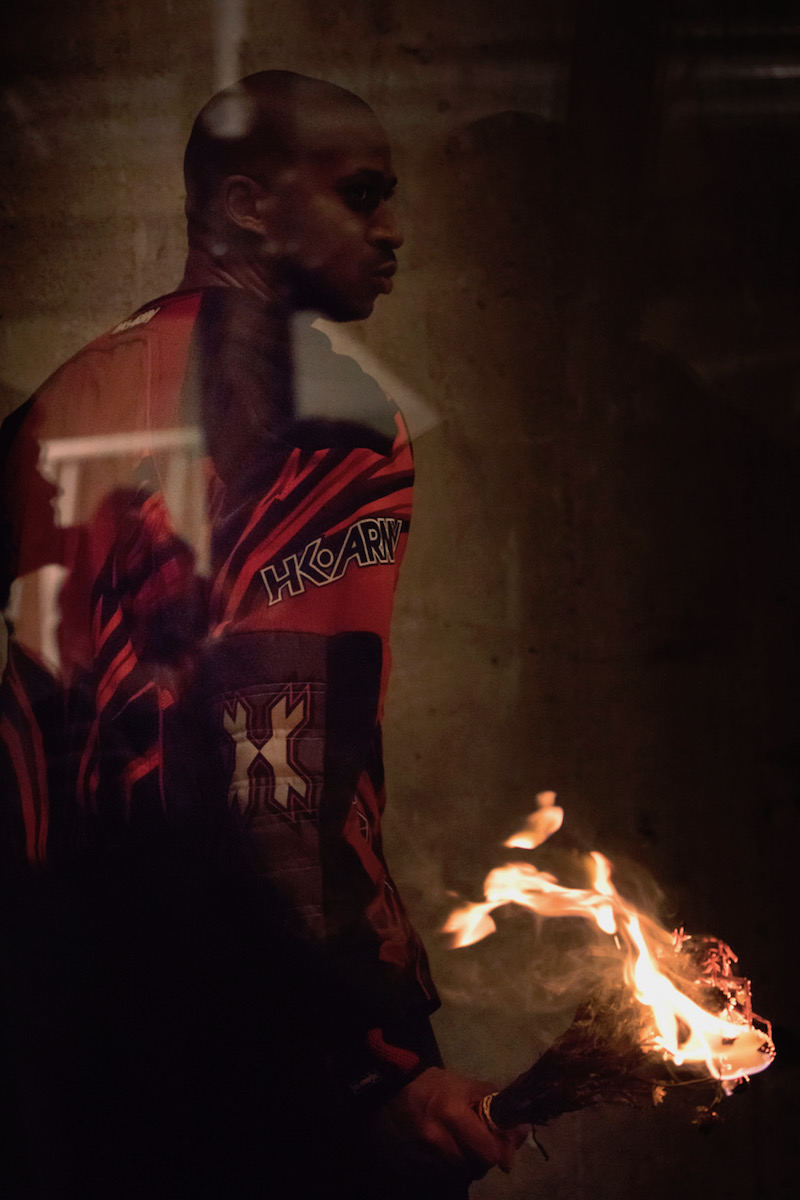
Josh Johnson in Anne Imhof, ‘Sex’, 2019, Tate Modern, London // Photography: Nadine Fraczkowski, Courtesy the artist and Galerie Buchholz, Berlin/Cologne/New York
Though we navigate the spaces of the Tanks in the presence of flocks of other viewers, the experience of ‘Sex’ does not feel like a particularly shared or collective one; in a sea of people, we are made to feel oddly alone. In one room of the Tanks, the performers look down upon us from a long platform; in the other, viewers congregate on a raised structure, pushing their way through the crowd to get a look at what is happening below. The duality of the structures reflects the duality between artist and audience, performer and viewer, as we flow from one corner of a room to the next, following the performers like hungry mosquitos.
Just as we elbow our way to the front of the horde, it appears that the crowd’s focus has shifted elsewhere. We are left with the perpetual feeling that we have missed something. In creating these layers of occurrences, Imhof challenges the conventional mechanisms of focus that accompany a performance. What lies in the foreground at one moment could fade into the background at another, while as viewers we struggle to recalibrate the ways in which we observe, unable to decide where to direct our attention. At times it seems that ‘Sex’ is moving in slow motion, as if the performers were swimming through a pool of syrup or floating in outer space. At other times, it feels that everything around us is speeding up; a tension rises but to no noticeable end. The atmosphere undulates between fast and slow, climactic buildup and a calm after the storm. Like scrolling through a feed of images, we zone in and out from one scene to another, stopping here and there to pause and take a closer look.
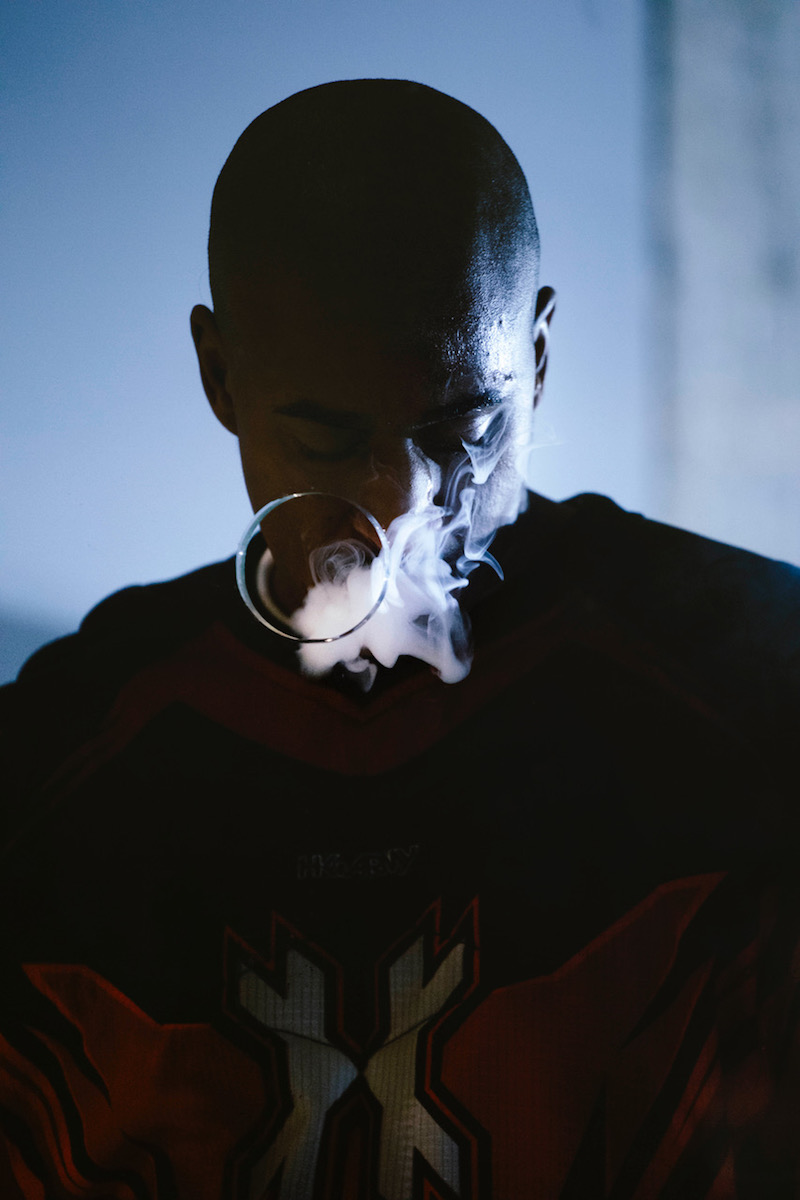
Josh Johnson in Anne Imhof, ‘Sex’, 2019, Tate Modern, London // Photography: Nadine Fraczkowski, Courtesy the artist and Galerie Buchholz, Berlin/Cologne/New York
We are reminded of this parallel each time the performers check their phones for the next cue from Imhof, who is always lurking in the depths of the crowd. One performer even raises his phone to the audience, mimicking the constant photo and video documentation that has become part and parcel to Imhof’s exhibitions. The room seems to collapse into a mirror image of itself in that moment, as the viewer records the performer recording the viewer and the rest of us look on. What are we even looking at?
After spending an hour in the room with strobe lights, my vision goes blurry, causing a glitch in my perception; I am disoriented. One performer stands with his back to the audience, cracking a whip against the wall over and over again, while the others pose nonchalantly, unfazed as they shroud themselves in clouds of vapor every couple of minutes with their vape pens. Ironic social commentary or obscure symbolism? This seems to be the name of the game in most of Imhof’s works, but of course the answer is never just one or the other.
From the oppositional spaces and androgynous performers to the way their bodies (and ours) echo each other as they move, ‘Sex’ is nonbinary in every sense of the word. It is not just a performance, but a performative experience; it is not just trendy, but a challenge to the very nature of trends; it is not just post-apocalyptic, but positioned toward the future. Beyond an artist, Imhof is a composer. Beyond passive viewers, we are actors in the contemporary condition of alienation. In a time of accelerationism and attention economies, it is no small feat to keep an audience on their toes for four hours, especially when they do not know what they are waiting for. Transcending categorization, ‘Sex’ is an exercise in the art of anticipation, as Imhof keeps us suspended in the space between binaries. Whether we stay because everyone else appears to be or because there is something vulnerable and oddly comforting about a place with no beginnings and no ends, it feels good to wait, for now.
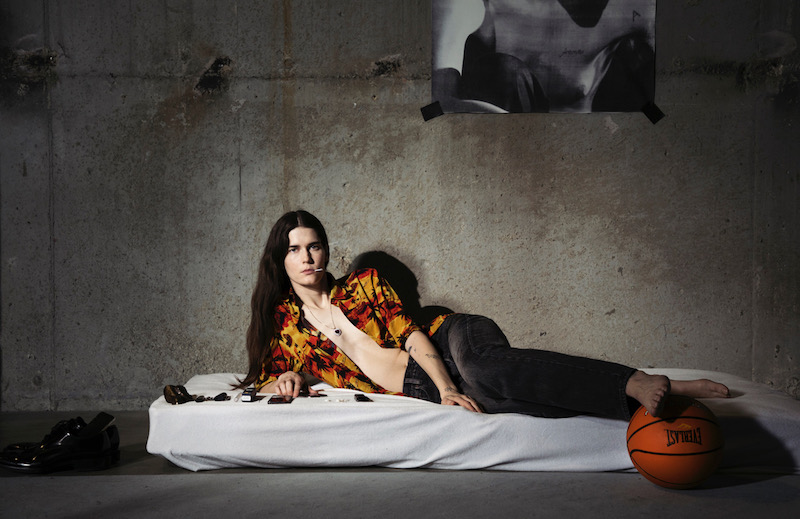
Eliza Douglas in rehearsal for BMW Tate Live Exhibition: Anne Imhof: ‘Sex’ at Tate Modern 2019 // Photography: Nadine Fraczkowski, Courtesy Galerie Buchholz, Berlin/Cologne/New York
This article is part of our monthly topic of ‘Nonbinary.’ To read more from this topic, click here.
‘Sex’ at Tate Modern is the first of three chapters in a project commissioned by Tate Modern, London, the Art Institute of Chicago, and Castello di Rivoli Museo d’Arte Contemporanea, Rivoli-Turin.
Exhibition Info
ART INSTITUTE OF CHICAGO
Anne Imhof: ‘Sex’
Exhibition: May 30–July 07, 2019
Performances: May 30; 3:30–7:30pm, May 31; 12:30–4:30pm, June 01; 12:30–4:30pm
111 South Michigan Avenue, Chicago, Illinois 60603, click here for map




















